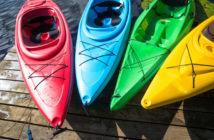Kayaks are one of the cheapest and most enjoyable ways to explore the water.
Many beginners, however, stumble when picking out the right kayak for their adventures.
What size kayak do I need? Should I get a sit-in or a sit-on-top kayak?
Check out this useful guide to learn more about kayak sizing and make sure you get the kayak that you’re looking for.
Intended Use
The first step to figuring out what size kayak you need is to think about how you plan to use it. There are several different varieties of kayaks, each with different intended uses and different sizing imperatives.
The most important types are:
- Recreational Kayaks
- Day Touring Kayaks
- Touring Kayaks
- Whitewater Kayaks
Recreational
Recreational kayaks are great for paddling around a lake, close to a shore or a gentle stream.
If you’re just getting into kayaking, a recreational kayak is a great place to start. This kind of kayak doesn’t usually have a lot of features or storage space but it’s definitely fun to play around in.
Recreational kayaks are easy to control and come in both sit-in and sit-on-top versions. Most recreational kayaks range between about seven and 12 feet long.
Day-Touring
Day-touring kayaks are a step up from recreational kayaks.
Day-touring kayaks usually have narrower widths and a more pronounced forward point, allowing them to track more effectively than recreational kayaks. You can easily use it for the same activities as a recreational kayak, but it is also great for taking one to two-day trips.
Touring
Touring kayaks are designed with long-distance travel in mind. They’re almost exclusively sit-in models and have a very narrow profile.
Touring models have significant watertight storage space and ample tie-down points. They track beautifully.
Touring kayaks are the longest variety of standard kayaks. High-end models can be more than 20 feet long. Everything about their shape, length, and width is designed to allow you to slice through the water with minimum resistance.
Whitewater
Whitewater kayaks are what most people picture when they think about kayaks. Small, highly maneuverable sit-in kayaks with a spray skirt around the passenger.
Whitewater kayaks have different design imperatives than other models. They have to withstand hard impacts and quickly weave around rapids and rocks.
A whitewater kayak is much shorter than a touring model. Most are about six to eight feet long. This makes them highly responsive and easy to right if flipped.
Sit-in vs Sit-On-Top
There are two broad categories that all kayaks fall under, sit-in and sit-on-top. Both styles of kayak provide their own benefits, but there are definite arguments for one style over the other depending on how you plan to use your kayak.
Sit-in
Sit-in kayaks allow a passenger to put their entire lower body into the kayak. This gives you protection from the sun and makes paddling more efficient.
Sit-in kayaks let you get really close to the water. This is great for stability.
The added contact your legs, back, and feet have with the boat also makes sit-in kayaks more controllable. Sit-in kayaks generally have more available storage space than sit-on-top models.
If you’re planning to go kayaking or camping, a sit-in model will definitely work better for you.
There are lots of accessories available for sit-in kayaks. Spray skirts help protect you from sea spray or splashes from rapids.
A word of warning: sit-in kayaks do accumulate water more than sit-on-top varieties. If you’re planning a long trip in a sit-in kayak it’s a good idea to bring a bilge pump to bail out water.
Almost every type of kayak mentioned above comes in a sit-in variety.
Sit-On-Top
Sit-on-top kayaks are used almost exclusively in the recreational market.
Because you’re on top of the kayak, you naturally find yourself farther from the water’s surface. This can make sit-on-top kayaks more prone to flipping than a sit-in model.
Sit-on-top kayaks aren’t as responsive or fast as similarly sized sit-in models. They’re almost always wider and shallower than sit-in models and make paddling less effective.
Sit-on-top kayaks are much easier to get on and off than sit-in kayaks. Most models come with built-in scupper holes so they’re self-draining in the event of a capsize.
You won’t be able to find touring or whitewater sit-on-top kayaks. Everything about their design makes them pretty useless for that purpose.
Sit-on-top kayaks are also heavier than sit-in kayaks of the same size.
Kayak Sizing
There are three things to consider when sizing a kayak: length, width, and depth.
Longer kayaks track better than shorter kayaks do. This lets a touring kayak move through the water faster and smoother than a shorter recreational one. It also allows it to maintain a straight line of travel better.
A longer kayak will naturally have more space available for storage as well.
The length of a kayak compared to its width affects its overall speed and ability to cut through rough waters and waves. Longer kayaks are less maneuverable than shorter ones. If you plan to do any whitewater kayaking definitely look towards the shorter end of the market.
The width of a kayak will have a big impact on its stability and speed. A wider kayak won’t flip as easily as a narrow one. That same kayak will move through the water slower than a narrower one.
A kayak’s depth mainly affects a passenger’s comfort and available storage space. If you have long legs it’s a good idea to look for a deeper kayak to give you more legroom. The same applies if you want to take multi-day trips along the coast or up a river.
The only real downside to a deeper kayak is its increased wind resistance.
Go With What Feels Right
The biggest things to keep in mind about kayak sizing are your comfort and how you plan to use your kayak.
If you just want to paddle around your local lake or seafront, then a shorter, shallow kayak will probably work fine. If you want to take long trips in your kayak it’s a good idea to look at how it tracks in the water and how comfortable you feel in it.
If you want to get into kayaking as a hobby, check out our reviews of popular kayaks.




